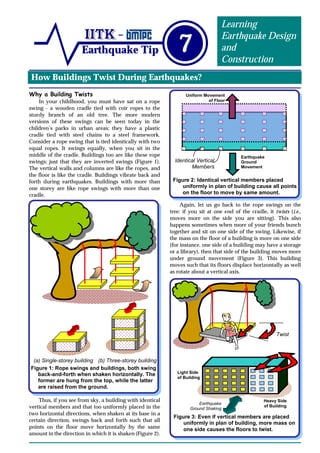
7
- 1. How Buildings Twist During Earthquakes? Earthquake Tip 7 Learning Earthquake Design and Construction Why a Building Twists In your childhood, you must have sat on a rope swing - a wooden cradle tied with coir ropes to the sturdy branch of an old tree. The more modern versions of these swings can be seen today in the children’s parks in urban areas; they have a plastic cradle tied with steel chains to a steel framework. Consider a rope swing that is tied identically with two equal ropes. It swings equally, when you sit in the middle of the cradle. Buildings too are like these rope swings; just that they are inverted swings (Figure 1). The vertical walls and columns are like the ropes, and the floor is like the cradle. Buildings vibrate back and forth during earthquakes. Buildings with more than one storey are like rope swings with more than one cradle. Thus, if you see from sky, a building with identical vertical members and that too uniformly placed in the two horizontal directions, when shaken at its base in a certain direction, swings back and forth such that all points on the floor move horizontally by the same amount in the direction in which it is shaken (Figure 2). Again, let us go back to the rope swings on the tree: if you sit at one end of the cradle, it twists (i.e., moves more on the side you are sitting). This also happens sometimes when more of your friends bunch together and sit on one side of the swing. Likewise, if the mass on the floor of a building is more on one side (for instance, one side of a building may have a storage or a library), then that side of the building moves more under ground movement (Figure 3). This building moves such that its floors displace horizontally as well as rotate about a vertical axis. Earthquake Ground Movement Uniform Movement of Floor Figure 2: Identical vertical members placed uniformly in plan of building cause all points on the floor to move by same amount. Identical Vertical Members Figure 1: Rope swings and buildings, both swing back-and-forth when shaken horizontally. The former are hung from the top, while the latter are raised from the ground. (a) Single-storey building (b) Three-storey building Figure 3: Even if vertical members are placed uniformly in plan of building, more mass on one side causes the floors to twist. Earthquake Ground Shaking Twist Light Side of Building Heavy Side of Building
- 2. IITK-BMTPC Earthquake Tip 7 How Buildings Twist During Earthquakes? page 2 Once more, let us consider the rope swing on the tree. This time let the two ropes with which the cradle is tied to the branch of the tree be different in length. Such a swing also twists even if you sit in the middle (Figure 4a). Similarly, in buildings with unequal vertical members (i.e., columns and/or walls) also the floors twist about a vertical axis (Figure 4b) and displace horizontally. Likewise, buildings, which have walls only on two sides (or one side) and thin columns along the other, twist when shaken at the ground level (Figure 4c). Buildings that are irregular shapes in plan tend to twist under earthquake shaking about a vertical axis. For example, in a propped overhanging building (Figure 5), the overhanging portion swings on the relatively slender columns under it. The floors twist about a vertical axis and also displace horizontally. What Twist does to Building Members Twist in buildings, called torsion by engineers, makes different portions at the same floor level to move horizontally by different amounts. This induces more damage in the columns and walls on the side that moves more (Figure 6). Many buildings have been severely affected by this excessive torsional behaviour during past earthquakes. It is best to minimize (if not completely avoid) this twist by ensuring that buildings have symmetry in plan (i.e., uniformly distributed mass and uniformly placed vertical members). If this twist cannot be avoided, special calculations need to be done to account for this additional shear forces in the design of buildings; the Indian seismic code (IS 1893, 2002) has provisions for such calculations. But, for sure, buildings with twist will perform poorly during strong earthquake shaking. Resource Material Arnold,C., and Reitherman,R., (1982), Building Configuration and Seismic Design, John Wiley, USA. Lagorio,H,J, (1990), EARTHQUAKES An Architect’s Guide to Non- Structural Seismic Hazard, John Wiley & Sons, Inc., USA. Next Upcoming Tip What is the Seismic Design Philosophy for Buildings? Authored by: C.V.R.Murty Indian Institute of Technology Kanpur Kanpur, India Sponsored by: Building Materials and Technology Promotion Council, New Delhi, India This release is a property of IIT Kanpur and BMTPC New Delhi. It may be reproduced without changing its contents and with due acknowledgement. Suggestions/comments may be sent to: eqtips@iitk.ac.in To see previous IITK-BMTPC Earthquake Tips, visit www.nicee.org October 2002 These columns are more vulnerable Figure 6: Vertical members of buildings that move more horizontally sustain more damage. Earthquake Ground Movement Figure 5: One-side open ground storey building twists during earthquake shaking. Earthquake Ground Shaking Figure 4: Buildings have unequal vertical members; they cause the building to twist about a vertical axis. Vertical Axis about which building twists Earthquake Ground Movement (b) Building on slopy ground (a) Swing with unequal ropes (c) Buildings with walls on two/one sides (in plan) Wall Columns Columns Wall Wall
